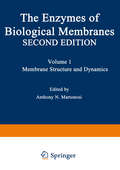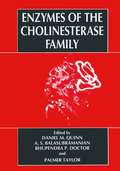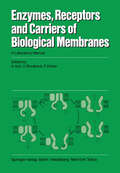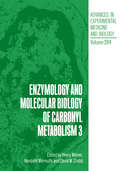- Table View
- List View
Enzymes in Industry: Production and Applications
by Wolfgang AehleLeading experts from all over the world present an overview of the use of enzymes in industry for: - the production of bulk products, such as glucose, or fructose - food processing and food analysis - laundry and automatic dishwashing detergents - the textile, pulp and paper and animal feed industries - clinical diagnosis and therapy - genetic engineering. The book also covers identification methods of new enzymes and the optimization of known ones, as well as the regulatory aspects for their use in industrial applications. Up to date and wide in scope, this is a chance for non-specialists to acquaint themselves with this rapidly growing field. '...The quality...is so great that there is no hesitation in recommending it as ideal reading for any student requiring an introduction to enzymes. ...Enzymes in Industry - should command a place in any library, industrial or academic, where it will be frequently used.' The Genetic Engineer and Biotechnologist 'Enzymes in Industry' is an excellent introduction into the field of applied enzymology for the reader who is not familiar with the subject. ... offers a broad overview of the use of enzymes in industrial applications. It is up-to-date and remarkable easy to read, despite the fact that almost 50 different authors contributed. The scientist involved in enzyme work should have this book in his or her library. But it will also be of great value to the marketing expert interested in the present use of enzymes and their future in food and nonfood applications.' Angewandte Chemie 'This book should be available to all of those working with, or aspiring to work with, enzymes. In particular academics should use this volume as a source book to ensure that their 'new' projects will not 'reinvent the wheel'.' Journal of Chemical Technology and Biotechnology
Enzymes in Industry: Products and Applications
by Wolfgang AehleLeading experts from all over the world present an overview of the use of enzymes in industry for: - the production of bulk products, such as glucose, or fructose - food processing and food analysis - laundry and automatic dishwashing detergents - the textile, pulp and paper and animal feed industries - clinical diagnosis and therapy - genetic engineering. The book also covers identification methods of new enzymes and the optimization of known ones, as well as the regulatory aspects for their use in industrial applications. Up to date and wide in scope, this is a chance for non-specialists to acquaint themselves with this rapidly growing field. '...The quality...is so great that there is no hesitation in recommending it as ideal reading for any student requiring an introduction to enzymes. ...Enzymes in Industry - should command a place in any library, industrial or academic, where it will be frequently used.' The Genetic Engineer and Biotechnologist
Enzymes in Nonaqueous Solvents: Methods and Protocols (Methods in Biotechnology #15)
by Evgeny N. Vulfson, Peter J. Halling and Herbert L. HollandEnzymatic catalysis has gained considerable attention in recent years as an efficient tool in the preparation of natural products, pharmaceuticals, fine chemicals, and food ingredients. The high selectivity and mild reaction con- tions associated with enzymatic transformations have made this approach an attractive alternative in the synthesis of complex bioactive compounds, which are often difficult to obtain by standard chemical routes. However, the maj- ity of organic compounds are not very soluble in water, which was traditi- ally perceived as the only suitable reaction medium for the application of biocatalysts. The realization that most enzymes can function perfectly well under nearly anhydrous conditions and, in addition, display a number of useful properties, e. g. , highly enhanced stability and different selectivity, has d- matically widened the scope of their application to the organic synthesis. Another great attraction of using organic solvents rather than water as a reaction solvent is the ability to perform synthetic transformations with re- tively inexpensive hydrolytic enzymes. It is worth reminding the reader that in vivo, the synthetic and hydrolytic pathways are catalyzed by different enzymes. However, elimination of water from the reaction mixture enables the “reversal” of hydrolytic enzymes and thus avoids the use of the expensive cofactors or activated substrates that are required for their synthetic count- parts.
Enzymes in Organic Synthesis (Novartis Foundation Symposia #111)
by Sarah Clark Ruth PorterThe Novartis Foundation Series is a popular collection of the proceedings from Novartis Foundation Symposia, in which groups of leading scientists from a range of topics across biology, chemistry and medicine assembled to present papers and discuss results. The Novartis Foundation, originally known as the Ciba Foundation, is well known to scientists and clinicians around the world.
Enzymes in the Valorization of Waste: Next-Gen Technological Advances for Sustainable Development of Enzyme based Biorefinery (Novel Biotechnological Applications for Waste to Value Conversion)
by Pradeep VermaEnzymes in the Valorization of Waste: Next-Gen Technological Advances for Sustainable Development of Enzyme-based Biorefinery focusses on key enzymes which are involved in the development of integrated biorefinery. It highlights the modern next-gen technologies for promoting the application of sustainable and greener enzymatic steps at industrial scale for the development of futuristic and self-sustainable "consolidated/integrated biorefinery/enzyme-based biorefinery." It also deals with technological advancement for improvement of enzyme yield or specificity, conversion capability, such as protein and metabolic engineering and advances in next generation technologies, and so forth. Features: • Explores all modern-day technologies that can potentially be used in enzyme-based biorefinery conversion of wastes to value-added products. • Covers technological, economic, and environmental assessments of enzyme-based biorefinery prospects. • Deliberates all possible products that can be generated from wastes including biofuel and essential chemicals. • Illustrates techniques for enhanced yield and properties to be used in various industrial applications. • Reviews advanced information of relevant sources and mechanism of enzymes. This book is aimed at graduate students, researchers and related industry professionals in biochemical engineering, environmental science, wastewater treatment, biotechnology, applied microbiology, biomass-based biorefinery, biochemistry, green chemistry, sustainable development, waste treatment, enzymology, microbial biotechnology, and waste valorization.
Enzymes in the Valorization of Waste: Next-Gen Technological Advances for Sustainable Development of Enzyme based Biorefinery (Novel Biotechnological Applications for Waste to Value Conversion)
by Pradeep VermaEnzymes in the Valorization of Waste: Next-Gen Technological Advances for Sustainable Development of Enzyme-based Biorefinery focusses on key enzymes which are involved in the development of integrated biorefinery. It highlights the modern next-gen technologies for promoting the application of sustainable and greener enzymatic steps at industrial scale for the development of futuristic and self-sustainable "consolidated/integrated biorefinery/enzyme-based biorefinery." It also deals with technological advancement for improvement of enzyme yield or specificity, conversion capability, such as protein and metabolic engineering and advances in next generation technologies, and so forth. Features: • Explores all modern-day technologies that can potentially be used in enzyme-based biorefinery conversion of wastes to value-added products. • Covers technological, economic, and environmental assessments of enzyme-based biorefinery prospects. • Deliberates all possible products that can be generated from wastes including biofuel and essential chemicals. • Illustrates techniques for enhanced yield and properties to be used in various industrial applications. • Reviews advanced information of relevant sources and mechanism of enzymes. This book is aimed at graduate students, researchers and related industry professionals in biochemical engineering, environmental science, wastewater treatment, biotechnology, applied microbiology, biomass-based biorefinery, biochemistry, green chemistry, sustainable development, waste treatment, enzymology, microbial biotechnology, and waste valorization.
Enzymes in the Valorization of Waste: Enzymatic Pretreatment of Waste for Development of Enzyme-based Biorefinery (Novel Biotechnological Applications for Waste to Value Conversion)
by Pradeep Verma"Enzymes in Valorization of waste: Enzymatic pre-treatment of waste for development of enzyme based biorefinery" focusses on the role of key delignifying enzymes (Laccase, MnP, LiP and LPMO’s) involved in biomass pre-treatment. The role of these enzymes such as hemicellulose, chitinases, and pectinases are discussed exhaustively including enzyme assisted recovery of high value phenolic compounds and value-added compounds generated during the pre-treatment process. All chapters cover broad topics and thematic areas associated with the pre-treatment step of biorefinery including enzyme mediated water treatment and its associated applications in biofuels, biorefineries and bioconversion. Features: Highlights mechanistic approach how the enzyme being able to regulate the delignification. Discusses advantages of the enzymatic delignification over other physical and chemical methods. Illustrates role of enzymes such as pectinase and chitinases and breaking down of biomass recalcitrance due to presence of pectin and chitin. Consolidates details on de-lignifying enzymes ((Laccase, MnP, LiP and LPMO’s) suitable in biomass pretreatment. Explores role of delignifying enzymes in high value phenolic compounds recovery during the enzymatic delignification. This book aims at Graduate students, Researchers and related Industry Professionals in Biochemical Engineering, Environmental Science, Wastewater Treatment, Biotechnology, Applied Microbiology, Biomass Based Biorefinery, Biochemistry, Green Chemistry, Sustainable Development, Waste Treatment, Enzymology, Microbial Biotechnology, and Waste Valorization.
Enzymes in the Valorization of Waste: Enzymatic Hydrolysis of Waste for Development of Value-added Products (Novel Biotechnological Applications for Waste to Value Conversion)
by Pradeep VermaEnzymes play a vital role in the enzymatic hydrolysis of waste for its conversion to useful value-added products. Enzymatic Hydrolysis of Waste for Development of Value-added Products focusses on the role of key enzymes such as cellulase, hemicellulases, amylases, and auxiliary enzymes (LMPOs), used in the hydrolysis step of the biorefinery setup. Further, it discusses the role of enzymes in the generation of reducing sugars and value-added compounds, with major emphasis on recent advances in the field. The mechanism, importance, type, evolution, and role of enzymes in hydrolysis constitute the crux of this volume, which is illustrated with examples and pertinent case studies. Features: • Explores the role of hydrolyzing enzymes in the breakdown and transformation of biomass hydrolysis. • Discusses the potential of auxiliary enzymes (LPMOs) for enhancing hydrolysis potential. • Covers recent developments in the field of enzymatic-assisted hydrolysis of waste for conversion of waste to value-added products. • Deliberates all possible products that can be generated from enzymatic hydrolysis of waste and their potential utilization. • Elucidates the limitations and advantages of enzyme-based hydrolysis and possible strategies for moving from the laboratory to large scale industries. This book is aimed at graduate students, researchers and related industry professionals in biochemical engineering, environmental science, wastewater treatment, biotechnology, applied microbiology, biomass-based biorefinery, biochemistry, green chemistry, sustainable development, waste treatment, enzymology, microbial biotechnology, and waste valorization.
Enzymes in the Valorization of Waste: Enzymatic Pretreatment of Waste for Development of Enzyme-based Biorefinery (Novel Biotechnological Applications for Waste to Value Conversion)
by Pradeep Verma"Enzymes in Valorization of waste: Enzymatic pre-treatment of waste for development of enzyme based biorefinery" focusses on the role of key delignifying enzymes (Laccase, MnP, LiP and LPMO’s) involved in biomass pre-treatment. The role of these enzymes such as hemicellulose, chitinases, and pectinases are discussed exhaustively including enzyme assisted recovery of high value phenolic compounds and value-added compounds generated during the pre-treatment process. All chapters cover broad topics and thematic areas associated with the pre-treatment step of biorefinery including enzyme mediated water treatment and its associated applications in biofuels, biorefineries and bioconversion. Features: Highlights mechanistic approach how the enzyme being able to regulate the delignification. Discusses advantages of the enzymatic delignification over other physical and chemical methods. Illustrates role of enzymes such as pectinase and chitinases and breaking down of biomass recalcitrance due to presence of pectin and chitin. Consolidates details on de-lignifying enzymes ((Laccase, MnP, LiP and LPMO’s) suitable in biomass pretreatment. Explores role of delignifying enzymes in high value phenolic compounds recovery during the enzymatic delignification. This book aims at Graduate students, Researchers and related Industry Professionals in Biochemical Engineering, Environmental Science, Wastewater Treatment, Biotechnology, Applied Microbiology, Biomass Based Biorefinery, Biochemistry, Green Chemistry, Sustainable Development, Waste Treatment, Enzymology, Microbial Biotechnology, and Waste Valorization.
Enzymes in the Valorization of Waste: Enzymatic Hydrolysis of Waste for Development of Value-added Products (Novel Biotechnological Applications for Waste to Value Conversion)
by Pradeep VermaEnzymes play a vital role in the enzymatic hydrolysis of waste for its conversion to useful value-added products. Enzymatic Hydrolysis of Waste for Development of Value-added Products focusses on the role of key enzymes such as cellulase, hemicellulases, amylases, and auxiliary enzymes (LMPOs), used in the hydrolysis step of the biorefinery setup. Further, it discusses the role of enzymes in the generation of reducing sugars and value-added compounds, with major emphasis on recent advances in the field. The mechanism, importance, type, evolution, and role of enzymes in hydrolysis constitute the crux of this volume, which is illustrated with examples and pertinent case studies. Features: • Explores the role of hydrolyzing enzymes in the breakdown and transformation of biomass hydrolysis. • Discusses the potential of auxiliary enzymes (LPMOs) for enhancing hydrolysis potential. • Covers recent developments in the field of enzymatic-assisted hydrolysis of waste for conversion of waste to value-added products. • Deliberates all possible products that can be generated from enzymatic hydrolysis of waste and their potential utilization. • Elucidates the limitations and advantages of enzyme-based hydrolysis and possible strategies for moving from the laboratory to large scale industries. This book is aimed at graduate students, researchers and related industry professionals in biochemical engineering, environmental science, wastewater treatment, biotechnology, applied microbiology, biomass-based biorefinery, biochemistry, green chemistry, sustainable development, waste treatment, enzymology, microbial biotechnology, and waste valorization.
The Enzymes of Biological Membranes: Volume 1 Membrane Structure and Dynamics
by A. N. MartonosiIn the first edition of The Enzymes of Biological Membranes, published in four volumes in 1976, we collected the mass of widely scattered information on membrane-linked enzymes and metabolic processes up to about 1975. This was a period of transition from the romantic phase of membrane biochemistry, preoccupied with conceptual developments and the general properties of membranes, to an era of mounting interest in the specific properties of membrane-linked enzymes analyzed from the viewpoints of modem enzymology. The level of sophistication in various areas of membrane research varied widely; the structures of cytochrome c and cytochrome b5 were known to atomic detail, while the majority of membrane-linked enzymes had not even been isolated. In the intervening eight years our knowledge of membrane-linked enzymes ex panded beyond the wildest expectations. The purpose of the second edition of The Enzymes of Biological Membranes is to record these developments. The first volume describes the physical and chemical techniques used in the analysis of the structure and dynamics of biological membranes. In the second volume the enzymes and met abolic systems that participate in the biosynthesis of cell and membrane components are discussed. The third and fourth volumes review recent developments in active transport, oxidative phosphorylation and photosynthesis.
The Enzymes of Biological Membranes: Volume 2 Biosynthesis of Cell Components (pdf)
by Anthony MartonosiThe Enzymes of Biological Membranes: Volume 3 Membrane Transport (FIRST EDITION)
by Anthony MartonosiMuch of the information currently available on the transport systems of bacterial and animal cell membranes and their mode of coupling to metabolic supply of energy can be found in this volume. Consideration of the participating enzymes dictated the choice of topics: Several transport systems where little information is available on the enzymology of the process are not included, while separate chapters deal with y-glutamyl transpeptidase and intestinal disaccharidases which meet many of the requirements of transport enzymes. The volume also includes two chapters on photosynthetic membranes as a general introduction to the topic. Other aspects of biological transport and photosynthesis will be developed in detail in a forthcoming volume now in preparation. These chapters reveal the excitement and rapid advance of the field, the daily reports of new concepts, new techniques, and new experimental findings which instantly interact to generate further progress. Our aim was to provide a starting point for those who are just beginning, and an opportunity for others to stop, take stock, and start in a new direction. My warmest thanks to all who contributed to this volume.
The Enzymes of Biological Membranes: Volume 3: Membrane Transport (SECOND EDITION)
by Anthony MartonosiIn the first edition of The Enzymes of Biological Membranes. published in four volumes in 1976, we collected the mass of widely scattered information on membrane-linked enzymes and metabolic processes up to about 1975. This was a period of transition from the romantic phase of membrane biochemistry, preoccupied with conceptual developments and the general properties of membranes, to an era of mounting interest in the specific properties of membrane-linked enzymes analyzed from the viewpoints of modem enzymology. The level of sophistication in various areas of membrane research varied widely; the structures of cytochrome c and cytochrome b were known 5 to atomic detail, while the majority of membrane-linked enzymes had not even been isolated. In the intervening eight years our knowledge of membrane-linked enzymes ex panded beyond the wildest expectations. The purpose of the second edition of The Enzymes of Biological Membranes is to record these developments. The first volume describes the physical and chemical techniques used in the analysis of the structure and dynamics of biological membranes. In the second volume the enzymes and met abolic systems that participate in the biosynthesis of cell and membrane components are discussed. The third and fourth volumes review recent developments in active transport, oxidative phosphorylation and photosynthesis.
The Enzymes of Biological Membranes: Volume 4 Bioenergetics of Electron and Proton Transport
by Anthony MartonosiIn the first edition of The Enzymes of Biological Membranes, published in four volumes in 1976, we collected the mass of widely scattered information on membrane-linked enzymes and metabolic processes up to about 1975. This was a period of transition from the romantic phase of membrane biochemistry, preoccupied with conceptual developments and the general properties of membranes, to an era of mounting interest in the specific properties of membrane-linked enzymes analyzed from the viewpoints of modem enzymology. The level of sophistication in various areas of membrane research varied widely; the structures of cytochrome c and cytochrome b were known s to atomic detail, while the majority of membrane-linked enzymes had not even been isolated. In the intervening eight years our knowledge of membrane-linked enzymes ex panded beyond the wildest expectations. The purpose of the second edition of The Enzymes of Biological Membranes is to record these developments. The first volume describes the physical and chemical techniques used in the analysis of the structure and dynamics of biological membranes. In the second volume the enzymes and met abolic systems that participate in the biosynthesis of cell and membrane components are discussed. The third and fourth volumes review recent developments in active transport, oxidative phosphorylation, and photosynthesis.
The Enzymes of Biological Membranes: Volume 2 Biosynthesis and Metabolism
by Anthony MartonosiIn the first edition of The Enzymes of Biological Membranes, published in four volumes in 1976, we collected the mass of widely scattered information on membrane-linked enzymes and metabolic processes up to about 1975. This was a period of transition from the romantic phase of membrane biochemistry, preoccupied with conceptual developments and the general properties of membranes, to an era of mounting interest in the specific properties of membrane-linked enzymes analyzed from the viewpoints of modem enzymology. The level of sophistication in various areas of membrane research varied widely; the structures of cytochrome c and cytochrome b were known s to atomic detail, while the majority of membrane-linked enzymes had not even been isolated. In the intervening eight years our knowledge of membrane-linked enzymes ex panded beyond the wildest expectations. The purpose of the second edition of The Enzymes of Biological Membranes is to record these developments. The first volume describes the physical and chemical techniques used in the analysis of the structure and dynamics of biological membranes. In the second volume the enzymes and met abolic systems that participate in the biosynthesis of cell and membrane components are discussed. The third and fourth volumes review recent developments in active transport, oxidative phosphorylation and photosynthesis.
The Enzymes of Biological Membranes: Volume 4: Electron Transport Systems and Receptors
by Anthony N. MartonosiFor a long time membrane biochemistry was almost synonymous with the bio chemistry of electron transport and oxidative phosphorylation. Although the successful analysis of hormone receptors, active transport, and other membrane-linked metabolic systems displaced mitochondria from the focus of interest, the field continued to grow and its contributions to other areas of membrane biochemistry played a major role in their dramatic development. The eight chapters in this volume dealing with electron transport provide a concise, critical, and up-to-date picture of the problems and accomplishments of the field. In the remainder of the volume a brief summary of selected receptor functions is presented. The relative novelty of this field naturally limits the factual scope of developments and encourages speculation. Nevertheless these reviews accurately reflect both accomplishments and deficiencies and provide objective guidance for future development. Several receptor functions omitted from these discussions will form one of the later volumes currently in preparation.
Enzymes of Lipid Metabolism: (pdf) (Advances in Experimental Medicine and Biology #101)
by Shimon GattEnzymes of Lipid Metabolism II (Nato Science Series A: #116)
by Louis Freysz Henri Dreyfus Raphaël Massarelli Shimon GattThis book presents the proceedings of the 2nd meeting on "Enzymes of Lipid Metabolism" which took place in Strasbourg in October, 1985. It is a sequel to the first conference bearing this title which took place, also in the vicinity of Strasbourg, in March, 1977. In either case the meetings were coorganized by L. Freysz of Strasbourg, France and S. Gatt of Jerusalem, Israel. The present meeting was set up as a joint NATO Advanced Research Workshop and CNRS-INSERM International Symposium. The conference was guided by two principles, namely, that science has no bounderies, neither has the study of lipid metabolism. Participants came from Europe, the USA, Israel and Japan and represented areas of research in lipid metabolism involving fatty acid s, cholesterylesters, glycero-and sphingolipids. The experimental approaches utilized purified enzymes, artificial and biological membranes, as well as a variety of cells, primary or cultured lines. A session was also devoted to modification of lipid enzymes and metabolism resulting from inherited, inborn defects such as the lipid storage diseases which are caused by genetic modification of degradative enzymes of lipid metabolism. A second type of disease stemming from a defect in a cell organnel (ie, the peroxisome) was also discussed. The eight and one and a half years which elapsed since the previous meeting, highlighted the changing emphasis of research in. lipid metabolism.
Enzymes of Molecular Biology (Methods in Molecular Biology #16)
by Michael M. BurrellThe scientist' s understanding of the cell at the molecular level has advanced rapidly over the last twenty years. This improved understa- ing has led to the development of many new laboratory methods that increasingly allow old problems to be tackled in new ways. Thus the modern scientist cannot specialize in just one field of knowledge, but must be aware of many disciplines. To aid the process of investigation, the Methods Molecular Biology series has brought together many protocols and has highlighted the useful variations and the pitfalls of the different methods. However, protocols frequently cannot be simply taken from the shelf. Thus the starting sample for a chosen protocol may be unavailable in the correct state or form, or the products of the procedure require a different sort of processing. Therefore the scientist needs more detailed information on the nature and requirements of the enzymes being used. This information, though usually available in the literature, is often widely dispersed and frequently occurs in older volumes of journals; not everyone has comprehensive library facilities available. Also many scientists searching out such information are not trained enzymologists and may be unaware of some of the parameters that are important in a specific enzyme reaction.
Enzymes of the Cholinesterase Family
by A. S. Balasubramanian Bhupendra P. Doctor Daniel M. Quinn Palmer TaylorThe Fifth International Meeting on Cholinesterases convened in Madras, India, in September of 1994. The long and rich history and culture of India provided an excellent setting for the meeting. More than 120 delegates from Asia, Australia, Europe and North America heard 54 oral presentations and viewed 54 posters on current research on enzymes of the cholinesterase family. The aim of this book is to compile the presentations of the Fifth International Meeting on Cholinesterases into a volume that describes recent investigations on the structure and catalytic function of acetylcholinesterase (AChE), butyrylcholinesterase (BuChE) and related enzymes, as well as studies on the molecular and cellular biology of these enzymes and the genes which encode them. Cholinesterases enjoy a long and storied history in diverse areas. In basic biochemical research, AChE is one of the best studied, though yet enigmatic, of enzymes. The efficient catalytic function of this enzyme presents the biochemist with a fundamental challenge in understanding the relationship between structure and function. AChE and BuChE belong to a family of proteins, the alB hydrolase fold family, whose constituents evolutionarily diverged from a common ancestor. Proteins in this family have a wide range of physiological functions. In commerce, AChE is a prime target for agricultural insect control, and for the development of therapeutic agents for Alzheimer's disease.
Enzymes, Receptors, and Carriers of Biological Membranes: A Laboratory Manual
by A. Azzi U. Brodbeck P. ZahlerThis manual follows at a distance of 3 years the previous one entitled Mem brane Proteins, and, like its predecessor, it is the result of an International Advanced Course sponsored by FEBS, SKMB and SNG, which was held in Bern in September 1983. The experiments offered to the students in the course had to be largely up· dated or chosen from new areas of membrane research, because of the sub stantial and rapid development of the field. Using the protocols of the course, the participants (graduate students, postdoctoral fellows and also senior scientists), in most cases not at all ex pert in biomembrane research, were able to repeat all the experiments suc cessfully. Those few protocols which for some reason did not fulfill the role we expected were modified. These protocols have now been collected in this manual, which we are able to offer to a number of biology, biochemistry and biophysics laborato ries, hoping that the selected number of methods which have been success fully used during the Advanced Course may be useful to them. This manual is also intented for teachers of practical classes, who may use it as a text book and as source of selected references, collected not in the library, but in the laboratory, from the notebooks of the young researchers who have contributed so much to the success of the Course.
Enzymes: A Very Short Introduction (Very Short Introductions)
by Paul EngelEnzymes are the astonishing, tiny molecular machines that make life possible. Each one of these small proteins speeds up a single chemical reaction inside a living organism many millionfold. Working together, teams of enzymes carry out all the processes that collectively we recognise as life, from making DNA to digesting food. This Very Short Introduction explains the why and the how of speeding up these reactions - catalysis - before going on to reveal how we have evolved these catalysts of such extraordinary power and exquisite selectivity. Paul Engel shows how X-ray crystallography has revealed the complex molecular shapes that allow enzymes to function at an extraordinarily sophisticated level. He also examines medical aspects of enzymes, both in the way faulty enzymes cause disease and in the way enzymes can be used for diagnosis and therapy. Finally, he looks at the many varied ways in which individual enzymes, taken out of their biological context, are used nowadays as tools - in washing powders, food production, waste treatment, and chemical synthesis. ABOUT THE SERIES: The Very Short Introductions series from Oxford University Press contains hundreds of titles in almost every subject area. These pocket-sized books are the perfect way to get ahead in a new subject quickly. Our expert authors combine facts, analysis, perspective, new ideas, and enthusiasm to make interesting and challenging topics highly readable.
Enzymology and Molecular Biology of Carbonyl Metabolism 3 (Advances in Experimental Medicine and Biology #284)
by David W. Crabb Henry Weiner Bendicht WermuthThe Fifth International Workshop on the Enzymology and Molecular Biology of Carbonyl Metabolism was held at Purdue University in June, 1990. This represents the fifth time that I had the privilege of organizing the scientific program. It was the first time that I actually hosted the meeting. I wish to salute my four previous co-organizers and the thousands of scientists who have hosted other meetings. It is much easier to arrange the scientific program and edit the proceedings. No local organization could occur without the help of ones research group and, in this case, my wife. I sincerely thank Esther and my research group for their advise and help. At this Workshop, similar to the preceeding ones, much new information was presented. It was apparent how molecular biological techniques were influencing the direction of the research on the three families of enzymes discussed. It also was apparent that not all biochemical problems could be solved by using these techniques. Many of the presentations showed how important advances still could be made using more traditional biochemical approaches.





















